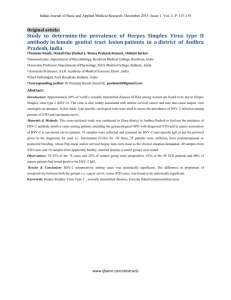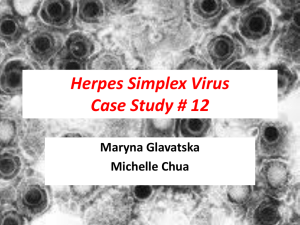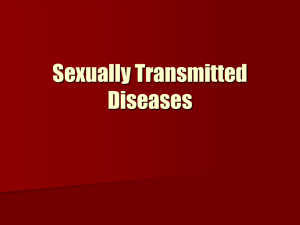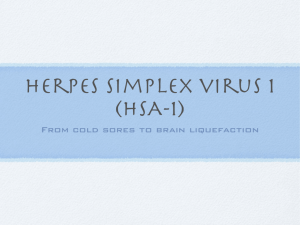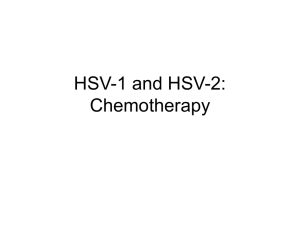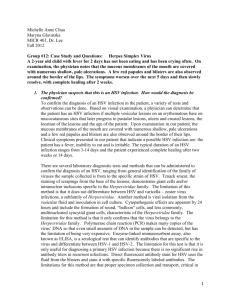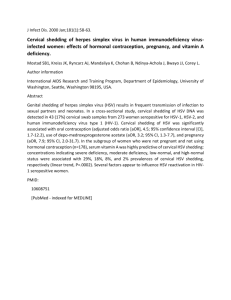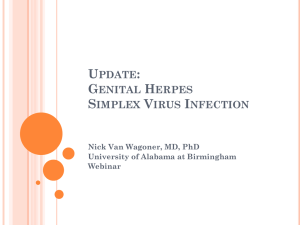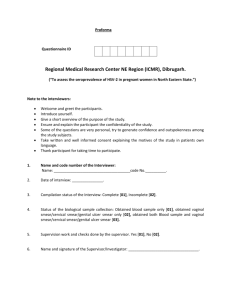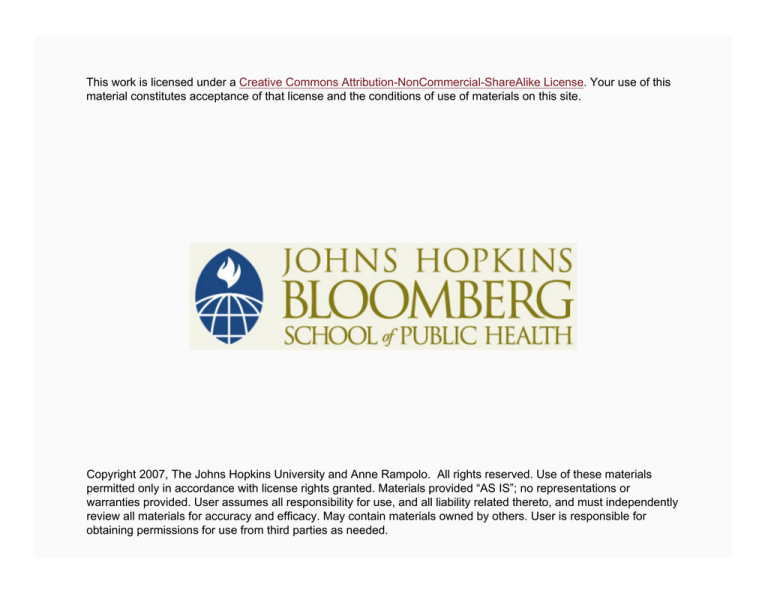
This work is licensed under a Creative Commons Attribution-NonCommercial-ShareAlike License. Your use of this
material constitutes acceptance of that license and the conditions of use of materials on this site.
Copyright 2007, The Johns Hopkins University and Anne Rampolo. All rights reserved. Use of these materials
permitted only in accordance with license rights granted. Materials provided “AS IS”; no representations or
warranties provided. User assumes all responsibility for use, and all liability related thereto, and must independently
review all materials for accuracy and efficacy. May contain materials owned by others. User is responsible for
obtaining permissions for use from third parties as needed.
Update on Genital Herpes
Anne Rompalo, MD, ScM
Johns Hopkins University
The Facts . . .
Genital herpes is recurrent, incurable
HSV is rarely fatal
There are two serotypes—HSV-1, HSV-2
Most recurrent genital herpes are HSV-2
At least 50 million are infected in U.S.
Most HSV-2 infected are not diagnosed
− They have mild or unrecognized infections
− But they shed intermittently from the genital tract
Most transmission occurs during asymptomatic
shedding episodes
3
What’s New?
More is known about . . .
− “A-typical” presentations
− Asymptomatic shedding
− Genital HSV-1
New serologic tests are FDA approved and available
− Proper use of these diagnostics may decrease
neonatal HSV transmission
No new approved drugs (but shorter regimens can be
used) and new drugs are in development
Suppressive therapy prevents transmission
NIH has vaccine trial underway
4
Section A:
Epidemiology
Genital Herpes—Initial Visits to Physicians’ Offices:
United States, 1966–2003
Visits (in thousands)
250
200
150
100
50
0
1966
69
72
75
78
81
84
Data Source: National Disease and Therapeutic Index (IMS Health)
87
90
93
96
99
2002
6
NHANES III: Results
From 1988 to 1994, the overall seroprevalence of HSV-2
was 21.9%
Compared to ‘76-80, the age-adjusted seroprevalence
increased 30%, with the greatest relative increase among
young whites
Women were 45% more likely than men to be infected
with HSV-2
Percent
40
32
24
16
NHANES II
NHANES III
8
0
12-19
20-29
30-39
40-49
50-59
60-69
70+
Age Group
7
Current Data:
Comparing NHANES III (1988-1994, N=9165) to
NHANES (1999-2000 N=3590)
−
−
Seroprevalence = 21.3% versus 17.6%; a decrease
of 17%
Largest decreases were in . . .
X Younger age groups
− 74% in 14-19 yr olds ( From 5.8% to 1.5% )
− 48% in 20-29 yr olds (From 17.2% to 8.9%)
− 35% for Males (from 17.2% to 11.2%)
− 46% in Mexican Americans (from 22.5% to
12.1%)
8
Tip of the Iceberg
9
The Clinical Spectrum of HSV-2
Up to 80-90% of HSV-2 seropositive patients have no
clinical history of genital HSV outbreaks
Most have mild unrecognized disease
Probably all shed intermittently
Asymptomatic
20%
Recognized
Symptomatic
20%
Undiagnosed
60%
10
Genital Herpes Due to HSV-1:
Data from University of Wisconsin Health Services
Retrospective review of HSV isolated collected over a
nine-year period
HSV-1 accounted for 78% of all genital herpes isolated
in 2001 compared to 31% in 1993
HSV-1 was more common in persons aged 16 to 21
compared to 22 or older
Source: Sex Transm Dis (2003), 30: 797-800
11
HSV-2 Incidence/Prevalence
Most HSV-2 is acquired in
third decade of life
BUT recent studies show
earlier acquisition
− Rates quintupled in white
teens and doubled in
young adults
Among teens
− Seroprevalence is > 5%
(4.5% white; 9% in black
students)
Among college students
− Seroprevalence is 1–9%
with high yearly
seroconversion
12
Summary of Epidemiologic Data, 2005
High prevalence of HSV-2 in most sexually
experienced populations
Most genital herpes is unrecognized
HSV-1 accounts for increasing proportion of first
genital herpes episodes
13
Section B
Pathogenesis
Pathogenesis of Genital HSV
Need mucosal inoculation
Virus is transported via peripheral nerve axon to
nerve cell bodies in dorsal root ganglia
Virus may remain latent indefinitely in paraspiinous
ganglia
Reactivation, viral replication, centrifugal migration
to mucosal surfaces, focal cell necrosis
Continued
15
Pathogenesis
Histopathologic changes
− Focal necrosis
− Ballooning degeneration of cells
− Production of multi-nucleated giant epithelial
cells
− Eosinophilic intra-nuclear inclusions called
Cowdry type A bodies
Continued
16
Section C
Clinical Manifestations
The Clinical Spectrum of HSV-2
Up to 80-90% of HSV-2 sero-positive patients
have no clinical history of genital HSV outbreaks
Most have mild unrecognized disease
Probably all shed intermittently
Asymptomatic
20%
Recognized
Symptomatic 20%
Undiagnosed
60%
18
Types of Infections
First clinical episode (primary)
− No infection ever
− No serum antibody when symptoms appear;
serum antibody appears in convalescence
− Clinically more severe
Continued
19
Types of Infections
First clinical episode (non-primary)
− First clinically apparent episode with HSV-1 or
HSV-2 in person previous seropositive to other
virus type
− Clinically milder
− 25% with HSV-2 have had a prior asymptomatic
primary infection
Continued
20
Types of Infections
Recurrent or first recognized
− Antibody is present when symptoms occur
although patient may not be aware of previous
episodes
− Generally, there is no or little change in antibody
titer in convalescence
− Disease is mild and short in duration
Source: Wald, A. NEJM (March 23, 2000), p. 844
Continued
21
Types of Infections
Asymptomatic infection
− Serum antibody is present
− No known history of outbreaks
− Up to 66% with identified asymptomatic HSV-2
can be taught to recognize clinical signs and
symptoms of genital outbreaks
Source: Wald, A. NEJM (March 23, 2000), p. 844
22
Type Specific Antibody at Time of Presentation
23
HSV Lesions
Macule
Papule
Vesicle
Ulcer
Crusted lesions
Healed lesion
24
Clinical Course of Initial Herpes Virus Infection
Duration
Viral Shedding
Vesicular
Pustule
Symptoms
-4 -2
Sexual
contact
Data Source: Corey, L. (1983) NEJM
0
2
4
Wet Ulcer
6
8
10
Dry Crusts
12
14
16 18
20 Days
Lesions Physician New Lesions Symptoms Lesions
noted contacted lesion
start gone unless healed
formation
to
lesions
common heal
irritated
25
Primary Infection
Often have systemic symptoms
− Fever, headache, malaise, myalgias (40% men; 70%
women)
− 10% women have urinary retention
− Symptoms peak within 3–4 days of lesion onset
and recede over the next 3–4 days
Continued
26
Primary Infection
Local symptoms
− Pain (95%), itching, dysuria (60%), vaginal (85%),
urethral (30%) discharge, tender
lymphadenopathy (80%)
− Lesions are numerous and bilateral; last 11–12
days; full healing takes average of 17–20 days
27
Primary HSV
Median duration of viral shedding is about 12 days
and correlates well with the time from vesicles to
crusting
Inguinal adenopathy peaks in week 2–3 and is often
last finding to resolve
Lymph nodes are firm, nonfluctuant, and tender to
palpation
28
Primary HSV Infection
Primary HSV cervicitis occurs in ~90% of primary
HSV-2 and ~70% of HSV-1
It may present as mucopurulent cervicitis, or may be
asymptomatic
Cervix will often appear abnormal with ulcerative
lesions, erythema, or friability
Exo- and endocervix may be involved
29
What about Recurrences?
Following the initial genital infection
− HSV becomes latent in the sacral nerve ganglia
and can reactivate
− About 85% of women and nearly all men with
symptomatic acquisition of genital HSV-2 will have
a recurrence within the first year (average 4–5
bouts/year)
Continued
30
What about Recurrences?
Following the initial genital infection
− Recurrent episodes are shorter and more localized
(may be chronic and unpredictable)
31
Recurrent Genital HSV
Triggers for reactivation may or may not be known
(trauma, fever, UVL, stress)
Prodromal symptoms (50%) begin 12–24 hours before
lesions and sometimes without lesions
Duration is shorter (painful lesions last four to six
days); shedding is shorter (four days)
Continued
32
Recurrent Genital HSV
Lesions tend to be unilateral
Average of 2–6 recurrences/year—but highly variable
Recurrence probability increases if . . .
− Primary is HSV-2
− Primary is severe/prolonged (>30 days)
Continued
33
Recurrent Genital HSV
HSV will recur more frequently and after shorter
period in men
Rate of cervical virus shedding in women is 12–20%
Continued
34
Asymptomatic Viral Shedding
Has been documented in almost all HSV-2 seropositive
persons studied
Most HSV-2 is transmitted during asymptomatic
shedding
Shedding rates are similar in patients with no reported
history of genital HSV (2.7%) compared to those with a
history (3.0%)
Continued
35
Asymptomatic Viral Shedding
Most common shedding sites
− Women—vulva and perianal areas
− Men—penile skin
Shedding rates are greater with HSV-2 than HSV-1
36
Reactivation of Genital HSV-2
In Asymptomatic Seropositive Persons
Prospective study of 53 HSV-2 antibody positive
patients with no history of genital HSV versus 90
patients with symptomatic HSV-2
Genital secretions were sampled daily and cultured for
HSV for median 94 days
Continued
37
Reactivation of Genital HSV-2
In Asymptomatic Seropositive Persons
Of 53 asymptomatic patients, HSV was detected in 38
(72%) by culture and by PCR in an additional four
(85%); 33 (62%) subsequently reported typical HSV
lesions
Rate of subclinical shedding was similar in both
groups (3.0% of symptomatic patients vs. 2.7% of
patients with no reported symptoms)
Continued
38
Reactivation of Genital HSV-2
In Asymptomatic Seropositive Persons
Among asymptomatic persons
− Duration of recurrences was shorter vs.
symptomatic persons (median three vs. five days, p
< 0.001)
− Frequency of recurrences was lower (3.0 per year
vs. 8.2 per year, p < 0.001)
− Shedding was similar comparing men to women
39
Diary: No Relationship of Symptoms to Shedding
40
Complications of Genital HSV
Aseptic meningitis
− More common in primary than in recurrent
infection
− More common with HSV-2 than HSV-1
− More common in women than in men (35% vs.
11% with primary disease)
Continued
41
Complications of Genital HSV
Aseptic meningitis
− May be severe and require hospitalization
− Usually no neurologic sequelae
− Recent data suggest that benign recurrent
meningitis (Mollaret’s meningitis) is usually caused
by HSV-2
42
Other Complications of Genital HSV
Stomatitis and pharyngitis
Radicular pain, sacral paresthesias
Transverse myelitis
Autonomic dysfunction—hyperesthesias, neurogenic
bladder, constipation, impotence
Continued
43
Other Complications of Genital HSV
Disseminated (viremic) infection—occasional in
patients with atopic eczema, pregnant women,
impaired CMI, neonates
− High mortality
− Fulminant hepatitis
Ocular involvement
− More common with HSV-1
Herpetic whitlow
− More common with HSV-1
44
Why Is Genital HSV Increasing?
Frequency of misdiagnosis
Lack of awareness with unintended spread
Chronicity of condition with lifelong infectivity
Occurrence of symptomatic viral shedding
Lack of cure
High rate of recurrence—90% recur at least once in
first year (60% have four or more)
45
Section D
Herpes: Diagnosis
Virus Detection Tests Available
Isolation of virus in culture
Modified culture techniques
− Shell vial or spin amplification methods
− ELVIS™ (Enzyme-Linked Virus-Inducible System)
Antigen detection
− Direct fluorescent antibody (FA)
− EIA (Herpchek)
DNA amplification methods
− Polymerase chain reaction (PCR)
− TaqMan, LightCycler
47
Accurate HSV Serology
Envelope:
gB, gC, gD, gE,
gG, gH, gI, gK,
gL, gM
Tegument:
VP16
Nucleocapsid:
VP5, ICP35
Glycoprotein gG tests
Western blot
gG ELISA
gG-membrane tests
gG immunoblot
DNA core
48
Table 1. Commercial Type-Specific gG-Based Serology Kits*
Manufacturer
HSV Type
HerpeSelect® ELISA
Focus
HSV-1, HSV-2
HerpeSelect® Immunoblot
Focus
HSV-1, HSV-2
POCkit® HSV-2
Off the market
Diagnology
HSV-2
Premier™ELISA
Off the market
Meridian
FDA Approved
Not FDA Approved
Cobas®-HSV-2
Roche
HSV-2
QuickVue® HSV-2
Quidel
HSV-1, HSV-2
* The Western blot assay, which is considered the gold standard, is not commercially available. HSV
indicates herpes simplex virus; FDA, Food and Drug Administration; ELISA, enzyme-linked immunoabsorbent assay.
49
Limitations of gG-Based tests
Antibodies to gG arise relatively late—first appearing
two to three months after infection in 60–70% of
newly infected persons
Therefore, Western blot detects seroconversion more
quickly (not a commercially available test)
Type specific IgM tests are under development
50
Limitations of gG-Based tests
The sensitivities of these assays for detection of HSV-2
range from 80-98% (false negative results may occur)
Specificities are high (>96%), but false-positive results
can occur, especially in patients with low likelihood of
infection
Therefore, repeat or confirmatory testing may be
indicated
51
Role of Serology in Clinical Management
Symptomatic—supplements virus detection efforts
− When lesions are negative for virus
− When lesions cannot be sampled for virus
− When lesions are healed or not present
Subclinical—high-risk patients
− Partner has genital herpes
− Sexual history
− Symptoms suggestive of atypical or
undiagnosed herpes
52
Section E
Herpes: Treatment
Recommended Regimen for First Clinical HSV Episode
Acyclovir 400 mg PO TID
Acyclovir 200 mg PO 5 x/day
Famcyclovir 250 mg PO TID
Valacyclovir 1 g PO BID
for 7-10 days or until clinical resolution
54
Recommended Regimen for Episodic Recurrent HSV
Acyclovir 400 mg PO TID
Acyclovir 200 mg PO five times daily
Acyclovir 800 mg PO BID
Famciclovir 125 mg PO BID
Valacyclovir 1 gm QD for five days
Valacyclovir 500 mg PO BID for three to five days
55
Daily Suppressive HSV Therapy
Among patients with frequent recurrences (> 6 per
year), reduces frequency by up to 93%
Safe and efficacious
Discontinue periodically (once a year) and reassess
56
Recommended Regimens for Daily Suppression of HSV
Acyclovir 400 mg PO BID
Famciclovir 250 mg PO BID
Valacyclovir 500 mg PO once a day
Valacyclovir 1.0 g QD if recurrence > 10 per year
57
Does Suppressive Therapy Decrease Subclinical Shedding?
Wald, A., et al. (1996). Ann Intern Med; 124: 8-15
− Double-blind, placebo-controlled, crossover
clinical trial comparing acyclovir 400 mg BID for 70
days, followed by a 14 days washout period, then
placebo or in reverse order
− 34 women with HSV 2 of less than two years’
duration
− Daily samples of vulvar cervicovaginal and perianal
areas, diary of symptoms
− Sub-clinical shedding occurred on 83 or 1439 days
with placebo (5.8%) vs. six of 1611 days on
acyclovir (0.37%)
− A 94% reduction
58
Mechanism of DNA Synthesis Inhibition of Acyclovir and New Drugs
Helicase-primase complex unwinds HSV-DNA at the
replication fork and primes both lagging and leading strands
New drugs bind to this complex and inhibit its activity at a
different site than acyclovir
59
Section E
Herpes: Treatment
Recommended Regimen for First Clinical HSV Episode
Acyclovir 400 mg PO TID
Acyclovir 200 mg PO 5 x/day
Famcyclovir 250 mg PO TID
Valacyclovir 1 g PO BID
for 7-10 days or until clinical resolution
61
Recommended Regimen for Episodic Recurrent HSV
Acyclovir 400 mg PO TID
Acyclovir 200 mg PO five times daily
Acyclovir 800 mg PO BID
Famciclovir 125 mg PO BID
Valacyclovir 1 gm QD for five days
Valacyclovir 500 mg PO BID for three to five days
62
Daily Suppressive HSV Therapy
Among patients with frequent recurrences (> 6 per
year), reduces frequency by up to 93%
Safe and efficacious
Discontinue periodically (once a year) and reassess
63
Recommended Regimens for Daily Suppression of HSV
Acyclovir 400 mg PO BID
Famciclovir 250 mg PO BID
Valacyclovir 500 mg PO once a day
Valacyclovir 1.0 g QD if recurrence > 10 per year
64
Does Suppressive Therapy Decrease Subclinical Shedding?
Wald, A., et al. (1996). Ann Intern Med; 124: 8-15
− Double-blind, placebo-controlled, crossover
clinical trial comparing acyclovir 400 mg BID for 70
days, followed by a 14 days washout period, then
placebo or in reverse order
− 34 women with HSV 2 of less than two years’
duration
− Daily samples of vulvar cervicovaginal and perianal
areas, diary of symptoms
− Sub-clinical shedding occurred on 83 or 1439 days
with placebo (5.8%) vs. six of 1611 days on
acyclovir (0.37%)
− A 94% reduction
65
Mechanism of DNA Synthesis Inhibition of Acyclovir and New Drugs
Helicase-primase complex unwinds HSV-DNA at the
replication fork and primes both lagging and leading
strands
New drugs bind to this complex and inhibit its activity at a
different site than acyclovir
66
Section F
Herpes: Prevention
What about Condoms?
Effect of condoms on reducing the transmission of
Herpes Simplex Virus Type 2 from men to women
Reduction from 8.5% to 0.9% incidence in discordant
couples (men Æ women)
No protective effect seen in women Æ men
68
Risk of HSV-2 Acquisition in a Prospective Study (N=528)
Risk
Hazard Ratio
Each additional sex act per week
1.16
Condom use >25% vs. ≤ 25%
0.38
Sex with lesions vs. no sex w/ lesions
2.01
Acyclovir use by source partner
0.64
T Notes Available
69
Transmission of HSV-2 in a Discordant Couple
Source: CDC
70
Once Daily Valaciclovir Reduces Transmission of Genital Herpes
L. Corey, S. Tyring, K. Beutner, T. Warren, S. Sacks, R.
Patel, A. Wald, G. Mertz, J. Paavonen, and the
International Valaciclovir Study Group
NEJM 2004; 350:11-20
71
Proportion of Susceptible Partners with HSV-2 Infection
Percentage with Infection
4.5
4.0
3.8%
3.5
(28/741)
P = 0.039
RR: 0.50 (95% CI: 0.26, 0.94)
3.0
50% Reduction
2.5
1.9%
2.0
(14/743)
1.5
1.0
0.5
0.0
Placebo
Valaciclovir
500 mg Once Daily
72
Frequency of Clinically Symptomatic Genital Herpes
2.5
in Susceptible Partners
2.3%
Percentage with Symptoms
(17/741)
2
P = 0.006
RR: 0.23 (95% CI: 0.08, 0.69)
1.5
77% Reduction
1
0.5%
0.5
(4/743)
0
Placebo
Valaciclovir
500 mg Once Daily
73
Conclusions: Valaciclovir 500 mg Once Daily
Suppressive therapy significantly reduced the rate of
transmission of . . .
− Symptomatic genital herpes by 77%
− HSV-2 infection by 50%
− Total HSV acquisitions by 61%
74
Vaccines?
HSV-2gD plus adjuvant—Smith Kline, in Phase 3 trials,
maybe data next year
− Information: www.herpevac.com
− 1-866-HERP-VAC
HSV-2 DISC—Paired mutants, single replication cycle
HSV-2gD—Nucleic acid vaccine
75
Section G
HSV and HIV: Relations and Affectations
HSV and HIV
Clinically can be more severe
Requires higher doses of therapy for longer duration
− Acyclovir 400 mg PO 3-5 x daily
− Famciclovir 500 mg BID
− Valacyclovir 1.0 gram PO BID for 5-10 days
77
Probability of HIV Transmission
78
Acquisition Probabilities per Act
by HSV-2 Status of HIV-Negative Partner
Acquisition
Probabilities perAct
HSV-2 Positive
0.0020**
HSV-2 Negative
0.0004
P = 0.01
79
Probability of HIV Acquisition per Sex Act
Transmission Probability/1000 Acts
Probability of HIV Acquisition per Sex Act by
HSV-2 in HIV-Negative Partner and Viral Load of
the HIV-Positive Partner
4
3
HSV-2 Positive
2
1
HSV-2 Negative
0
<1700
1700-
12,500-
38,500+
Log Viral Load copies/mL
Continued
80
Probability of HIV Acquisition per Sex Act
Transmission Probability/1000 Acts
Probability of HIV Acquisition per Sex Act by
HSV-2 Serostatus and Age of HIV-Negative
Partner
4
3
HSV-2 Positive
2
1
HSV-2 Negative
0
15-24
25-29
30-34
35-59
Age
81
Acquisition Probabilities per Act
by GUD and HSV in HIV-Negative Partner
Acquisition Probabilities
per Act
GUD+/HSV+
0.0031
GUD-/HSV+
0.0019
GUD-/HSV-
0.0004*
82
Prevalence of HSV-2 and HIV
Prevalence of HSV-2 and HIV
60
HSV-2
Prevalence (%)
50
40
30
HIV-1
20 10
0
15-19
20-24
25-29
AGE
83
HSV-2 and HIV: Rakai Data
GUD risk factor for HIV acquisition (RR~3.0)
45% of GUDs are due to HSV-2 (Multiplex PCR)
Age and sex-specific prevalence of HSV-2 mirrors that
of HIV
84

